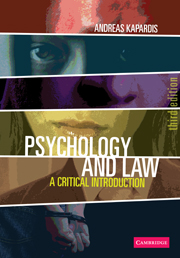Book contents
- Frontmatter
- Contents
- List of case studies
- Acknowledgements
- Foreword
- 1 Psycholegal Research: An Introduction
- 2 Eyewitnesses: Key Issues and Event Characteristics
- 3 Eyewitnesses: The Perpetrator and Interviewing
- 4 Children as Witnesses
- 5 The Jury
- 6 Sentencing as a Human Process, Victims, and Restorative Justice
- 7 The Psychologists as Expert Witnesses
- 8 Detecting Deception
- 9 Witness Recognition Procedures
- 10 Psychology and the Police
- 11 Conclusions
- Notes
- References
- Index
2 - Eyewitnesses: Key Issues and Event Characteristics
- Frontmatter
- Contents
- List of case studies
- Acknowledgements
- Foreword
- 1 Psycholegal Research: An Introduction
- 2 Eyewitnesses: Key Issues and Event Characteristics
- 3 Eyewitnesses: The Perpetrator and Interviewing
- 4 Children as Witnesses
- 5 The Jury
- 6 Sentencing as a Human Process, Victims, and Restorative Justice
- 7 The Psychologists as Expert Witnesses
- 8 Detecting Deception
- 9 Witness Recognition Procedures
- 10 Psychology and the Police
- 11 Conclusions
- Notes
- References
- Index
Summary
Testimony to personal identity is proverbially fallacious.
(William James, 1890:97)The status of the eyewitness as the best and most reliable source of evidence has been severely undermined … Identification parades provide only limited safeguards against wrongful identifications … The fact that a witness has confidence in the identification is no indication that it is right … Legal systems are still struggling to accommodate scientists' doubts about reliability.
(McEwan, 2003:203)Memories, unlike videotapes or photocopies, are personally constructed. And that is why two people can experience the same event and recall it differently.
(Myers, 2001:317)It is important not to exaggerate the fallibility of human memory. Memory is often wonderfully detailed and accurate.
(Lindsay and Read, 1994:293)INTRODUCTION
The above quotes reflect the concern over the years with the limitations of eyewitness testimony, the more recent acceptance of the fact that the whole process of observing and recalling faces and events is a complex, interactive and dynamic one and, finally, that we should not overlook the fact that such testimony can be accurate. To illustrate, a Dutch study by Van Koppen and Lochun (1997) analysed data on individual characteristics of suspects pertaining to 1650 real-life robbery eyewitness descriptions and found that the degree of agreement between the witness description and the police description was, for gender and eyeshape (100 per cent), hair colour (73 per cent), face shape (69 per cent), race (60 per cent), height (52 per cent) and ears protruding (50 per cent).
- Type
- Chapter
- Information
- Psychology and LawA Critical Introduction, pp. 23 - 56Publisher: Cambridge University PressPrint publication year: 2009



